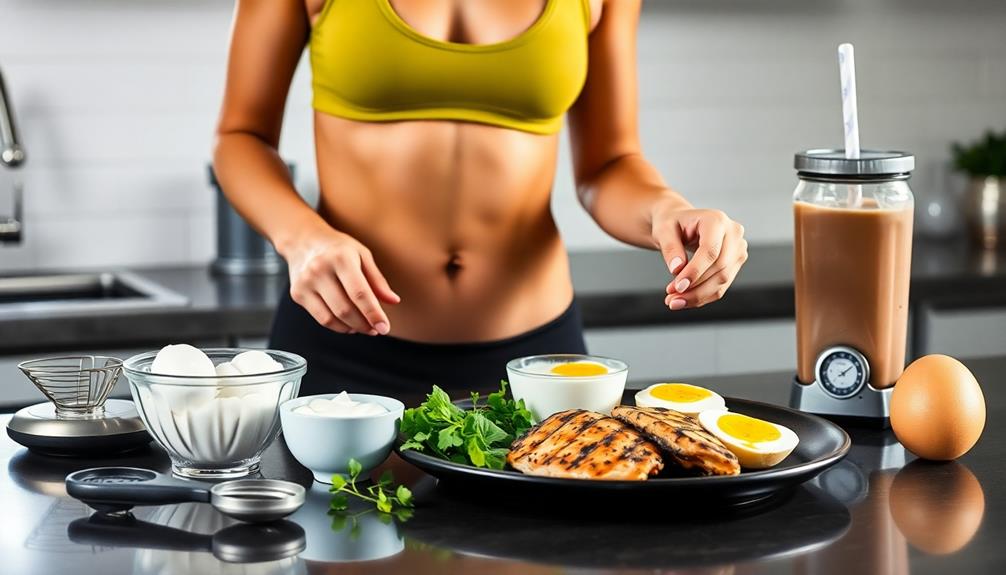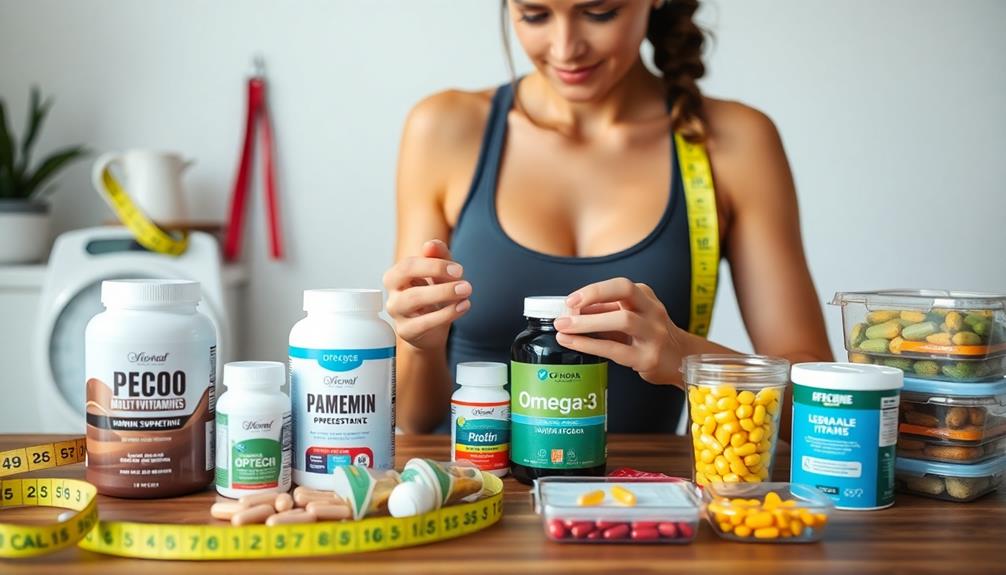To create an effective cutting diet plan, start by calculating your calorie deficit. Aim for 10-20% below your TDEE to lose 0.5-1% of body weight weekly. Balance your macronutrients with 30-35% protein, 35-40% carbs, and 25-30% fat. Consume 1.6-2.2 grams of protein per kilogram of body weight to preserve muscle mass. Consider carb cycling to optimize fat loss and energy levels. Include healthy fats from sources like avocados and fatty fish. Stay hydrated and monitor your progress, adjusting as needed. Remember to account for hormonal fluctuations that may affect your results. By following these guidelines, you'll be on your way to achieving your cutting goals.
Core Insight
- Calculate your TDEE and create a 10-20% calorie deficit to promote gradual fat loss.
- Aim for a protein intake of 1.6-2.2g per kg of body weight to preserve muscle mass.
- Implement carb cycling by rotating between high, moderate, and low carb days to optimize fat loss.
- Include healthy fats from sources like avocados and nuts, limiting intake to 20-30% of daily calories.
- Adjust macronutrient ratios to approximately 30-35% protein, 35-40% carbs, and 25-30% fat for effective cutting.
Understanding Calorie Deficit

To slim down, the most important thing is creating a calorie deficit. This means eating less calories than your body uses up. When you do this, your body has to use stored fat for energy, and you lose weight.
First, figure out your TDEE, which is the total calories your body burns in a day. Then, eat 10-20% less than that number. Some women like to take supplements like CLA and L-Carnitine to help lose fat and keep muscle while cutting calories.
Don't cut calories too much though, or your metabolism can slow down and you might lose muscle. Aim to lose about 0.5-1% of your weight each week. This is a steady rate that you can stick with. Make sure you still eat enough to keep your body working well and to maintain your muscle.
Keep track of what you eat and make changes if needed to reach your goals.
Calculating Macronutrient Ratios

Cutting diets require a calorie deficit and the right balance of macronutrients: protein, carbs, and fat. Each one plays a key role in keeping your body working well. When cutting, you'll want to change the amounts of each to help keep muscle and lose fat. Protein powders like grass-fed whey can be a great way to get enough high-quality protein.
A typical macro split for cutting is:
- Protein: 30-35% of calories
- Carbs: 35-40% of calories
- Fat: 25-30% of calories
To figure out your macros, first decide on your daily calorie goal. Then, multiply this number by the percentage for protein, carbs, and fat. Last, divide each result by the calories per gram (protein and carbs have 4, fat has 9). This tells you how many grams of protein, carbs, and fat to eat each day.
Protein Requirements for Muscle Preservation

Protein is crucial when cutting calories because it helps your body maintain muscle while losing fat. It also keeps you feeling full and supports your metabolism. Grass-fed whey protein is an excellent option for women looking to increase their protein intake during a cut. It's easy for your body to use and packed with nutrients.
Aim for 1.6 to 2.2 grams of protein per kilogram of body weight each day when cutting. This higher intake ensures your muscles have the amino acids they need to recover and grow.
Good protein sources include lean meats, fish, eggs, Greek yogurt, beans, and tofu. Spread your protein intake evenly across the day by including some at each meal and snack.
Carbohydrate Cycling Strategies

Carb cycling is a great way for women to lose fat and keep muscle while cutting. The basic idea is to change the amount of carbs you eat each day. You'll have high carb days, medium carb days, and low carb days.
On high carb days, you'll do tough workouts to maintain your muscle. Low carb days are when you'll focus on burning fat with HIIT exercise. Moderate carb days let your body recover in between.
It's important to adjust your protein and fat to match your carb levels. This ensures you stay within your daily calorie goals for cutting. By cycling your carbs, you'll have the energy you need for workouts while still losing fat.
Healthy Fat Sources

Healthy fats are just as important as carbs in your cutting diet. They help your body make hormones, absorb nutrients, and keep you feeling full. Choose fats that have a lot of omega-3s and monounsaturated fats, like:
- Avocados
- Nuts and seeds (almonds, walnuts, chia seeds)
- Olive oil
- Fatty fish (salmon, mackerel, sardines)
These fats can help with inflammation and keep your heart healthy. If you're doing a keto cutting plan, these fats are even more important because they're your main source of energy.
Watch your portion sizes, though, because fats have a lot of calories. Try to get 20-30% of your daily calories from healthy fats. This will help you keep your energy up and support your body while you're cutting. By adding these fat sources to your diet, you'll make sure you're getting all the nutrition you need and can stick with your plan throughout your cutting phase.
Meal Timing and Frequency

Meal timing and frequency matter when cutting. Spread your meals out during the day to keep your energy up and appetite in check. Try to eat 3-5 times per day, with snacks, based on what works for you.
A basic meal plan could look like this:
Breakfast around 7-8 AM to get your metabolism going
Lunch between 12-1 PM for a midday refuel
Dinner from 6-7 PM to help you recover
Hydration and Electrolyte Balance

Staying hydrated is key when cutting calories. It helps prevent tiredness, headaches, and muscle cramps. Drink at least 8-10 glasses of water a day. Drink more if you exercise a lot or live somewhere hot. Electrolyte gummies are a tasty option during tough workouts.
To stay hydrated and keep electrolytes balanced:
- Sip water all day long
- Eat leafy greens and bananas for electrolytes
- Try sugar-free electrolyte drinks when you work out hard
- Check your pee color; light yellow means you're hydrated
Supplementation for Cutting

Supplements can boost your cutting diet's success. When eating fewer calories, your body needs the right nutrients. Think about adding these supplements during your cut:
- Whey protein powder to help keep muscle
- A multivitamin to avoid nutrient deficiencies
- Fish oil to lower inflammation
- BCAAs to help muscles recover
Whey protein stops muscle loss while in a calorie deficit. Multivitamins fill in missing nutrients from eating less. Fish oil is good for overall health and fighting inflammation. BCAAs may help tired muscles bounce back faster after workouts.
Just remember – supplements aren't magic. They work best combined with a good diet and exercise plan. Always check with your doctor before trying new supplements.
Hormonal Considerations for Women

Women's bodies have unique hormonal changes that can affect weight loss. When cutting, you need to consider how these changes impact your progress. Your menstrual cycle influences metabolism, water retention, and cravings. Pay attention to these hormonal shifts and adjust your diet plan as needed. Some women may find keto supplements helpful for managing hormones during a cutting phase.
Key hormonal factors for women when cutting:
- Estrogen affects fat storage and metabolism
- Progesterone can increase appetite and water retention
- Cortisol may rise during strict dieting, impacting fat loss
- Thyroid hormones are important for regulating metabolism
Monitoring Progress and Adjustments
Tracking your progress and making changes are key parts of a successful cutting diet. Each week, record your weight, body measurements, and take progress photos. The scale doesn't always reflect your full progress, so also pay attention to how your clothes fit and your energy levels. Be mindful about sharing personal information online when documenting your journey, as fitness apps and websites may gather your data.
If you aren't getting the results you want, it's time to adjust your plan. Consider lowering your calorie intake a bit, eating more protein, or changing your workouts slightly. Little tweaks can add up to big progress over time.
Stay patient and stick with it. Progress often slows down or stalls for a while, which is normal. If you reach a plateau, don't worry. Look over your diet and exercise plan again, and think about getting personalized advice from a nutritionist or trainer. Keep your goals in mind and believe in the process.
Frequently Asked Questions
How Long Should a Cutting Diet Last for Optimal Results?
You'll typically see best results with a cutting diet lasting 8-12 weeks. However, it's important to listen to your body and adjust as needed. Don't rush the process; sustainable weight loss takes time and patience.
Can I Drink Alcohol While on a Cutting Diet?
It's best to avoid alcohol while cutting. If you do drink, limit yourself to occasional light consumption. Alcohol adds empty calories, slows fat burning, and can lead to poor food choices. Stick to water or zero-calorie beverages instead.
What's the Best Way to Deal With Hunger During a Cut?
To deal with hunger during a cut, you'll want to focus on high-volume, low-calorie foods. Eat plenty of vegetables, drink water, and consume protein-rich meals. Don't skip meals, and try eating smaller portions more frequently throughout the day.
How Much Cardio Should Be Incorporated Into a Cutting Diet Plan?
You should incorporate 3-5 cardio sessions per week, lasting 30-45 minutes each. Focus on a mix of high-intensity interval training and steady-state cardio. Don't overdo it, as too much cardio can hinder muscle retention.
Are Cheat Meals Allowed During a Cutting Phase?
You can incorporate occasional cheat meals during a cutting phase, but they should be planned and limited. Don't overindulge, as it may hinder your progress. Stick to your calorie deficit and treat cheat meals as rare exceptions.

